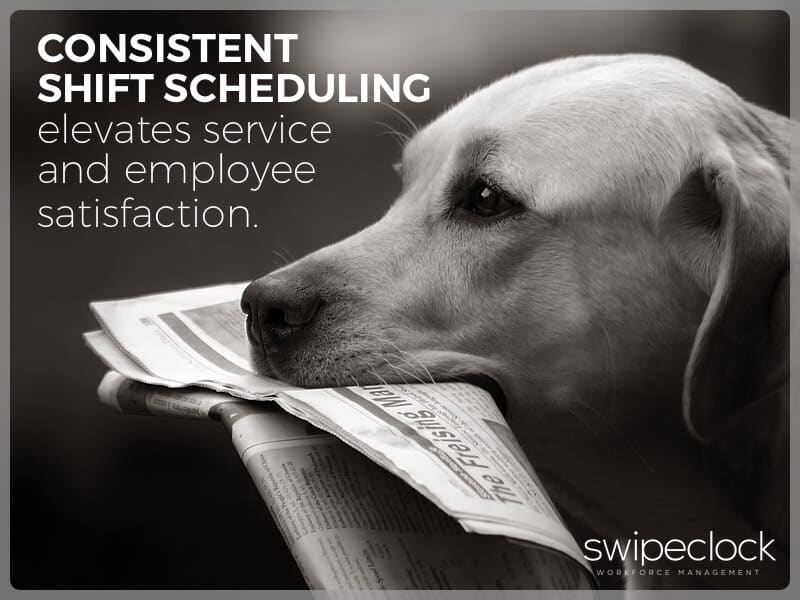Consistent Shift Scheduling Elevates Service, Employee Satisfaction

Shift scheduling impacts both customer and employee satisfaction. You can dramatically improve your schedules with shift scheduling software. Improved schedules make for happy employees, and happy employees mean satisfied customers.
But there’s one thing you should know…
It’s impossible to optimize your scheduling using spreadsheets alone.
Why?
Spreadsheets don’t let you use scheduling best practices.
A spreadsheet is passive. It is an application for recording data. It may seem leaps ahead of a dry erase board, but in tech years, basic spreadsheets are still in the Jurassic period.
If you are using basic spreadsheets, you are not alone. Most small business owners have not yet adopted scheduling software—even though it is far more effective than spreadsheets.
Why not?
Because they have misconceptions about shift scheduling software.
If you are using basic spreadsheets, you are missing out on several techniques. (If you are using pen and paper—skip the spreadsheets and jump right to automated scheduling software.)
“But isn’t shift scheduling software expensive?”
This is one of the persistent myths I was talking about. And it couldn’t be further from the truth.
Shift scheduling software has become cost-effective for even small businesses.
What’s the big change?
Scheduling software can now be accessed in the cloud. That means you don’t need to install any software on your company computers. Your service provider hosts your system and keeps your data safe. (Their business depends on it.)
It gets better:
You won’t have to burden your IT department. Your software provider will keep the system running and deal with tech problems. (They might even guarantee that the system will be up and running 95% or 98% of the time.)
You won’t have to call someone in your own IT department to solve problems. Neither will you have to worry about having the latest version running on your server; the latest version is always running for you.
Think of using cloud-hosted systems as paying for a “subscription” to the platform.
There are more ways it is cheaper…
You don’t have to pay for:
- Software updates
- Licensing Fees
- New hardware
And you won’t have to worry about backing up your data. Software as a Service (SaaS) companies have rigorous backup systems to protect your data in the event of an emergency. You don’t have to worry about a thing.
You might be wondering how cloud-based software is affordable for small businesses.
Let me explain…
Your provider serves multiple businesses like yours. Because of this, economies of scale come into play. Scale is what allows a SaaS company to provide more service for lower costs. Their model is volume; they serve a lot of companies with a scalable software service. You get more for your money, and they take advantage of a high volume of customers.
It’s a win-win!
With most systems, you won’t even have to sign a contract. You pay based on how many employees you are scheduling. Most SaaS providers are month-to-month, too, so you won’t have to worry about long-term contracts.
This is great if your staff fluctuates during the year.
“Isn’t scheduling software hard to use?”
Scheduling software isn’t hard to use. In fact; it’s usually the opposite. Modern scheduling software is easy to install, and even easier to use for both managers and employees.
If you can use a smartphone, you can make complex schedules with automated scheduling software. Scheduling software is designed for the small business owner, with complexity built into simplified features that make it easy to use.
Will it take forever to be up and running?
You can be up and be running the same day you sign up. There is nothing to install, and creating a new account takes only minutes. Setting up the details of your company can take an hour or two, but once you are set, you can take advantage of templates, automation, and optimized workflow to save even more time.
Hopefully, we have overcome your misconceptions. It really is easy to get started with cloud-based shift scheduling software.
So what’s so great about shift scheduling software?
1. It solves problems you have right now
2. It lets you do things with shift scheduling you can’t do with spreadsheets
How can shift scheduling software solve my company’s problems?
- Avoid shorthanded shift schedules and shift gaps
- Prevent overstaffing and inefficient shift coverage
- Respond to fluctuating staffing demands in less time
- Improve employee morale
- Eliminate shift schedule confusion between staff and management
- Gain control over labor costs
- Reduce the time it takes to create shift schedules
- Prevent manager burnout
- Better forecast shift schedule needs
- Steer clear of high labor costs
Bottom line?
Cloud-based shift scheduling software allows you to create consistent shift schedules. Consistent shift schedules give employees a reliable foundation. When your employees feel like things are stable, they are able to focus on delivering customer satisfaction.
As a manager, you’ll get more done in less time. Happy managers go a long way to creating happy employees, and that helps make your company more successful.
What’s more:
You do it fast and easy.
What Is The Goal Of Consistent Scheduling?
The goal of consistent shift scheduling is a high level of customer satisfaction. You also want to create a high level of employee satisfaction while keeping labor costs as low as possible.
That’s a tall order. If a manager focuses on any one area while excluding the others, there are problems. Even focusing on two areas while ignoring the third is problematic. Balancing all three will require a capable shift scheduling software service.
Here’s an example…
Consider a call center manager who focuses only on customer service and low labor costs. The company uses just-in-time scheduling to keep the phones covered. For every shift, a group of part-time employees is scheduled as “on call.” When there is an unexpected busy period, the employees on standby are called in. They jump on the phones and keep queue times short. So far so good. They stay until the surge in call volume has passed.
The manager prevents full-time employees from accruing overtime, so labor costs don’t increase.
But there is a big price to be paid for this type of scheduling…
It results in a lower overall quality of service, low employee satisfaction, and increased turnover.
Employees hate unpredictable scheduling.
Some of the on-call employees end up working only a couple of hours. They have already arranged their day to be available but they earn very little money for it. The personal cost is reduced outside activity or unplanned interruptions to time off. No one likes to be on call, and when they are called in, frustration can be the result.
This increases job turnover. The business ends up with a constant churn of employees with little experience. Customers interact with inexperienced employees. Inexperienced employees take longer to solve customer’s problems and you lose efficiency. Customers can see this, and return business will begin to drop.
Turnover rates can climb so high that a company never has enough people on staff to adequately cover all the shifts.
If your company is using spreadsheets and has high employee turnover it may be due to bad shift schedules.
You need a solution fast. You need shift scheduling software that can be set up in an hour or two.
How do you choose your scheduling software?
Look for the flexibility to customize for your type of business. Shift schedule templates help reduce the time it takes to create and post new shift schedules.
Look for PTO accrual tracking. Manual accrual tracking can be a full-time job, and the potential for error can be costly.
Make sure you have scalability. Cloud-based shift schedule software has scalability built in. You want it to scale with you as you grow.
If you have more than one location, make sure it is set up for remote and mobile access. Mobile clock-in solutions help reduce the time it takes to collect time cards and reduce transfer errors and late time cards. Web-based clocks help with multiple locations and telecommuting.
Payroll integration is a must-have. Not all systems integrate with payroll software, and this is a critical component of automated shift scheduling. The time saved with automated integration to payroll will more than pay for your upgrade. The cost savings in human error will make this a profit center. Make sure you upgrade to shift scheduling with payroll integration.
Once you have upgraded to a modern shift scheduling software service, it’s time to put it to use.
How do you set up your scheduling software?
Believe it or not, getting set up with cloud-based scheduling software is the easy part. You’ll need to create a new company account with basic contact information. Next, you’ll need to set up your company profile. Profiles will include company information and preferences settings. For example, whether you want to create shift schedules by the day, week, or month.
You’ll also need to enter each employee’s personal information. The time it takes for this step can be reduced if you provide your employees with a login to the self-service hub. Employees can contribute to the process by completing their own profile. Profiles include shift availability, job role certifications, and even tax information.
Modern shift scheduling software allows you to import your existing employee data without having to manually enter it.
Outsource Your Memory
I am talking about actual brain cells here. Each employee profile contains data your shift schedule software uses to alert you to problems. When you’ve created employee profiles, it’s easy to create schedules.
Use a template for the basic framework. Good scheduling software has templates ready-built for specific industries—say manufacturing or retail. Drag and drop employee names into slots. Since you’ve created employee profiles, the system will alert you to conflicts, overtime, or inappropriate job roles.
You won’t accidentally schedule an employee for a shift they can’t work. By setting rules for shifts, you will be alerted if you don’t have workers with the necessary certifications.
We haven’t even talked about compliance yet.
One of the biggest benefits is having compliance tools. Modern shift schedule software allows you to set overtime alerts. Create rules for meals and breaks so the software intelligently figures them into the shift schedule.
If you are subject to Payroll Based Journal requirements, you have tools for staff-patient ratios and shift differentials. Set alerts for any fair shift scheduling laws you must comply with.
Experienced Employees Give Better Customer Service
Providing consistent schedules to employees pays off in improved morale and lower turnover.
Both of these factors improve customer service. And it goes beyond simply having enough employees to cover a shift.
Let me explain:
Work teams with experienced employees have more “institutional knowledge.” This is the type of knowledge that isn’t found in training manuals. It manifests itself when an experienced employee models effective problem-solving for a new employee. There is an atmosphere of competence and confidence. Veteran employees remember solutions to problems that have never been formally documented. New employees learn from observation and participation.
Now we will assume that you have implemented your shift scheduling software and are ready to start applying best practices.
How To Create Consistent Schedules
1. Seek Employee Input
This starts before they are your employees. When interviewing, ask the candidate when they would like to work. This prevents many problems later on. No matter how bright and capable a job seeker seems if they can’t work when you need them, move on.
2. Schedule Early
Last-minute scheduling is burdensome for employees. So burdensome that cities and states are passing fair scheduling laws that define shift scheduling periods to protect employees.
Why do managers have difficulty creating schedules two weeks or a month in advance? It takes so long to make a schedule with a spreadsheet—you can hardly keep a week ahead let alone a month. With automated shift scheduling software, you create shift schedule templates and then copy them for each new period. Tweak as needed. It doesn’t take long when the basic schedule is in place. You never have to “start all over again.”
3. Use Non-Standard Shifts
With spreadsheets, it’s hard enough to create schedules for standard shifts. 24-hour facilities and rotating shifts are even more complicated. With scheduling software, you can handle all types of shifts and shift scheduling methods.
Schedule shifts by day, week or month, and allocate resources by individual, team, or job role. Using templates and job roles as your basis can save significant time and effort each period.
And this is key.
You will be able to accommodate employees’ schedule preferences while maintaining staffing levels. You will suddenly have a larger hiring pool. Depending on your industry, you can now consider more part-time employees and maybe even at-home employees.
You are aligning supply and demand with a shift scheduling tool designed for optimization. With different types of shifts, you have more ways to create the most efficient shift schedules.
What type of shifts can you add to the mix?
Flexible 40 hrs/week shift
Your full-time employees may want to work 4 ten-hour shifts or mix days and nights. This option may be perfect for some of your employees.
Slant Schedules
These work well when Mondays are busiest and staffing demands decrease during the week. An example of a slant schedule is Mon 8-6 (10 hours), Tues 8-5 (9 hours), Wed 9-5 (8 hours), and so on. The schedule still totals 40 hours.
Rotating Work Schedules
Businesses with around-the-clock staffing needs use rotating schedules to distribute the less-desirable shifts. Employees cycle through the day, swing, and graveyard. This type of scheduling is used at hospitals, power plants, security, police and fire departments.
Some employees feel that rotating shift schedules wreak havoc with their sleep/wake cycles, but others enjoy the flexibility.
4. Allow Shift Trading
Some employers are afraid that if they allow shift bartering it will become a chaotic free-for-all.
When all employees can see the schedule online and bid for shifts, it actually works great. Employees who need extra hours can see what’s available. Managers can approve shift trades at a glance.
Virtual trade boards empower employees to take responsibility for making sure shifts are filled. Managers retain ultimate approval over shift swapping, but virtual trade boards make it easier to manage, and a lot less work.
Empowered employees are happy employees.
5. Use Employee Self-Service (ESS)
As was mentioned above, employee self-service can take a lot of work off your plate. Employee self-service hubs allow employees to take control of their own profile information. They can even view historic time and attendance, scheduling, and payroll information.
Employee self-service takes the burden from managers and offers employees the freedom to manage their own data in the system. The result is that more employee data will be current, and managers are less likely to be interrupted by routine data updates.
Summary
Automated shift scheduling software helps you create consistent shift schedules. Consistent shift schedules elevate employee satisfaction. Happy employees take better care of your customers. Happy customers come back for more.
WorkforceHUB has everything you need.
By Liz Strikwerda and Cary Snowden
Simplify HR management today.
Simplify HR management today.
How Improving Candidate Engagement Influences the Hiring Process
Applicants invest considerable time, effort, and thought into their job applications. Regrettably, it’s all too common for employers to delay responses, with some failing to provide any follow-up whatsoever. Such practices can have a negative effect on the candidate experience, influencing your organization’s hiring efficiency and reputation. Ensuring a positive experience for candidates is crucial…
Read More9 Best Receipt Apps for Small Businesses and Freelancers in 2024
As a business owner or freelancer, you’re spinning many plates at once. You’re keeping up with payroll, making pitches, nurturing your email marketing funnel, and much more. All to maintain and grow your business. The last thing you need is to panic each month as you look for receipts at expense report time. Administrative work…
Read More




